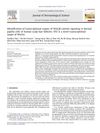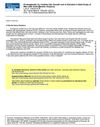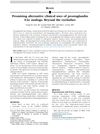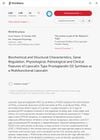Search
for
Did you mean Prostaglandin D2 Receptor?
Learn
4 / 4 resultslearn Cetirizine
popular antihistamine showing promise for hair loss as an anti-inflammatory and prostaglandin inhibitor
learn Latanoprost
glaucoma medication with hair follicle stimulant effects
learn Minoxidil
An essential vasodilator with some anti-androgenic effects, has excellent safety record
Research
5 / 1000+ resultsresearch Hypertrichosis and Hyperpigmentation in the Periocular Area Associated with Travoprost Treatment
Using travoprost for glaucoma may cause extra hair growth and darker skin around the eyes, but these effects can reverse after stopping the drug.

research Identification of Transcriptional Targets of Wnt/β-Catenin Signaling in Dermal Papilla Cells of Human Scalp Hair Follicles: EP2 Is a Novel Transcriptional Target of Wnt3a
Wnt3a activates certain genes in hair follicle cells, including a newly discovered one, EP2, which may affect hair growth.

research Prostaglandin D2 Inhibits Hair Growth and Is Elevated in Bald Scalp of Men with Androgenetic Alopecia
PGD2 stops hair growth and is higher in bald men with AGA.

research Promising Alternative Clinical Uses of Prostaglandin F2α Analogs: Beyond the Eyelashes
Prostaglandin F2α analogs show promise for treating certain types of hair loss but need more research for other skin conditions.

research Biochemical and Structural Characteristics, Gene Regulation, Physiological, Pathological and Clinical Features of Lipocalin-Type Prostaglandin D2 Synthase as a Multifunctional Lipocalin
Lipocalin-Type Prostaglandin D2 Synthase (L-PGDS) is a protein that plays many roles in the body, including sleep regulation, pain management, food intake, and protection against harmful substances. It also affects fat metabolism, glucose intolerance, cell maturation, and is involved in various diseases like diabetes, cancer, and arthritis. It can influence sex organ development and embryonic cell differentiation, and its levels can be used as a diagnostic marker for certain conditions.
Community Join
5 / 86 resultscommunity You will lose hair if your prostaglandins aren't in balance
Prostaglandin balance affects hair loss, particularly in conditions like Lichen Planopilaris, where an imbalance can lead to hair follicle damage. Treatments mentioned include prostaglandin analogs and Pioglitazone HCL, with a focus on maintaining prostaglandin equilibrium for potential hair regrowth.

community Compressed part of research of theory of androgenic/anabolitic balance. AGA h-responders analytic. Theory of physio-metabolitic method of anti AGA treatment
The treatment for androgenetic alopecia involves using finasteride and minoxidil with intense exercise and cold exposure to boost metabolism and reduce androgenic effects, potentially leading to hair regrowth. This approach may activate biological pathways for improved hair and overall health.
community UPDATE: The theory that explains everything. Please help me make this big!
Hair loss theory involves 3alpha-hydroxysteroid reductase (3AHD) converting DHT to androstenol. Discussion explores potential treatments and encourages more research.
community COMPLETE OVERVIEW of the Treatment of androgenetic alopecia in men
Male androgenetic alopecia is commonly treated with topical minoxidil and oral finasteride, both requiring continuous use. Other options include hair restoration surgery, dutasteride, light therapy, and camouflaging agents.
community Min/Fin 3 months difference - 23yo dude
A 23-year-old experienced significant hair regrowth in 3 months using a topical mixture of minoxidil 5% and finasteride 1%, with added bimatoprost. The treatment is government-subsidized, costing around $15, and the user reported no side effects.